Xiaoran Fan
Mitigating Object Hallucinations in MLLMs via Multi-Frequency Perturbations
Mar 19, 2025Abstract:Recently, multimodal large language models (MLLMs) have demonstrated remarkable performance in visual-language tasks. However, the authenticity of the responses generated by MLLMs is often compromised by object hallucinations. We identify that a key cause of these hallucinations is the model's over-susceptibility to specific image frequency features in detecting objects. In this paper, we introduce Multi-Frequency Perturbations (MFP), a simple, cost-effective, and pluggable method that leverages both low-frequency and high-frequency features of images to perturb visual feature representations and explicitly suppress redundant frequency-domain features during inference, thereby mitigating hallucinations. Experimental results demonstrate that our method significantly mitigates object hallucinations across various model architectures. Furthermore, as a training-time method, MFP can be combined with inference-time methods to achieve state-of-the-art performance on the CHAIR benchmark.
EliteKV: Scalable KV Cache Compression via RoPE Frequency Selection and Joint Low-Rank Projection
Mar 03, 2025Abstract:Rotary Position Embedding (RoPE) enables each attention head to capture multi-frequency information along the sequence dimension and is widely applied in foundation models. However, the nonlinearity introduced by RoPE complicates optimization of the key state in the Key-Value (KV) cache for RoPE-based attention. Existing KV cache compression methods typically store key state before rotation and apply the transformation during decoding, introducing additional computational overhead. This paper introduces EliteKV, a flexible modification framework for RoPE-based models supporting variable KV cache compression ratios. EliteKV first identifies the intrinsic frequency preference of each head using RoPElite, selectively restoring linearity to certain dimensions of key within attention computation. Building on this, joint low-rank compression of key and value enables partial cache sharing. Experimental results show that with minimal uptraining on only $0.6\%$ of the original training data, RoPE-based models achieve a $75\%$ reduction in KV cache size while preserving performance within a negligible margin. Furthermore, EliteKV consistently performs well across models of different scales within the same family.
Predicting Large Language Model Capabilities on Closed-Book QA Tasks Using Only Information Available Prior to Training
Feb 06, 2025Abstract:The GPT-4 technical report from OpenAI suggests that model performance on specific tasks can be predicted prior to training, though methodologies remain unspecified. This approach is crucial for optimizing resource allocation and ensuring data alignment with target tasks. To achieve this vision, we focus on predicting performance on Closed-book Question Answering (CBQA) tasks, which are closely tied to pre-training data and knowledge retention. We address three major challenges: 1) mastering the entire pre-training process, especially data construction; 2) evaluating a model's knowledge retention; and 3) predicting task-specific knowledge retention using only information available prior to training. To tackle these challenges, we pre-train three large language models (i.e., 1.6B, 7B, and 13B) using 560k dollars and 520k GPU hours. We analyze the pre-training data with knowledge triples and assess knowledge retention using established methods. Additionally, we introduce the SMI metric, an information-theoretic measure that quantifies the relationship between pre-training data, model size, and task-specific knowledge retention. Our experiments reveal a strong linear correlation ($\text{R}^2 > 0.84$) between the SMI metric and the model's accuracy on CBQA tasks across models of varying sizes (i.e., 1.1B, 1.6B, 7B, and 13B). The dataset, model, and code are available at https://github.com/yuhui1038/SMI.
Distill Visual Chart Reasoning Ability from LLMs to MLLMs
Oct 24, 2024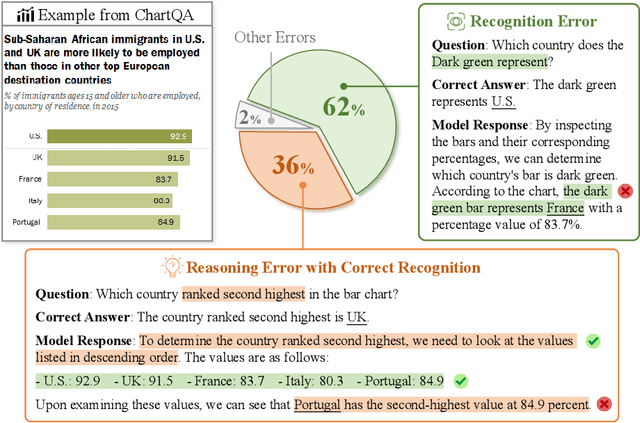



Abstract:Solving complex chart Q&A tasks requires advanced visual reasoning abilities in multimodal large language models (MLLMs). Recent studies highlight that these abilities consist of two main parts: recognizing key information from visual inputs and conducting reasoning over it. Thus, a promising approach to enhance MLLMs is to construct relevant training data focusing on the two aspects. However, collecting and annotating complex charts and questions is costly and time-consuming, and ensuring the quality of annotated answers remains a challenge. In this paper, we propose Code-as-Intermediary Translation (CIT), a cost-effective, efficient and easily scalable data synthesis method for distilling visual reasoning abilities from LLMs to MLLMs. The code serves as an intermediary that translates visual chart representations into textual representations, enabling LLMs to understand cross-modal information. Specifically, we employ text-based synthesizing techniques to construct chart-plotting code and produce ReachQA, a dataset containing 3k reasoning-intensive charts and 20k Q&A pairs to enhance both recognition and reasoning abilities. Experiments show that when fine-tuned with our data, models not only perform well on chart-related benchmarks, but also demonstrate improved multimodal reasoning abilities on general mathematical benchmarks like MathVista. The code and dataset are publicly available at https://github.com/hewei2001/ReachQA.
Have the VLMs Lost Confidence? A Study of Sycophancy in VLMs
Oct 15, 2024



Abstract:In the study of LLMs, sycophancy represents a prevalent hallucination that poses significant challenges to these models. Specifically, LLMs often fail to adhere to original correct responses, instead blindly agreeing with users' opinions, even when those opinions are incorrect or malicious. However, research on sycophancy in visual language models (VLMs) has been scarce. In this work, we extend the exploration of sycophancy from LLMs to VLMs, introducing the MM-SY benchmark to evaluate this phenomenon. We present evaluation results from multiple representative models, addressing the gap in sycophancy research for VLMs. To mitigate sycophancy, we propose a synthetic dataset for training and employ methods based on prompts, supervised fine-tuning, and DPO. Our experiments demonstrate that these methods effectively alleviate sycophancy in VLMs. Additionally, we probe VLMs to assess the semantic impact of sycophancy and analyze the attention distribution of visual tokens. Our findings indicate that the ability to prevent sycophancy is predominantly observed in higher layers of the model. The lack of attention to image knowledge in these higher layers may contribute to sycophancy, and enhancing image attention at high layers proves beneficial in mitigating this issue.
Leveraging Foundation Models for Zero-Shot IoT Sensing
Jul 29, 2024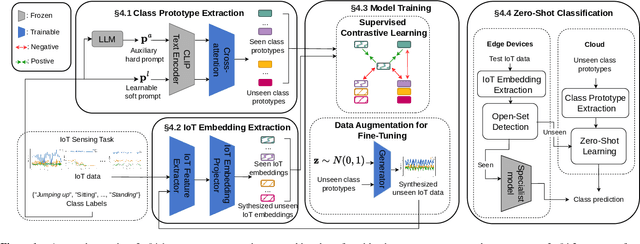
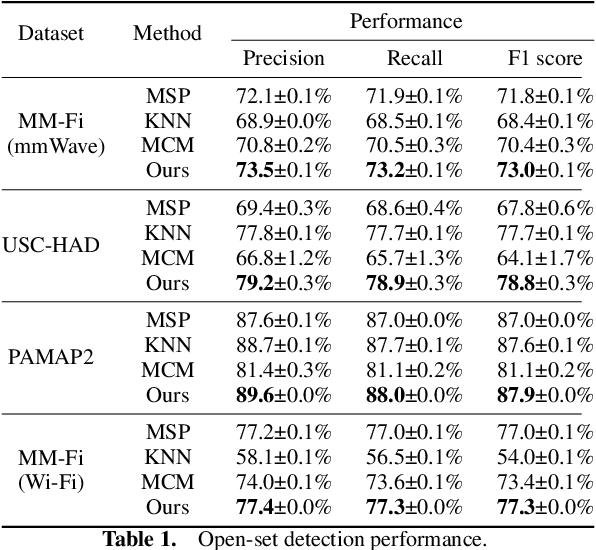

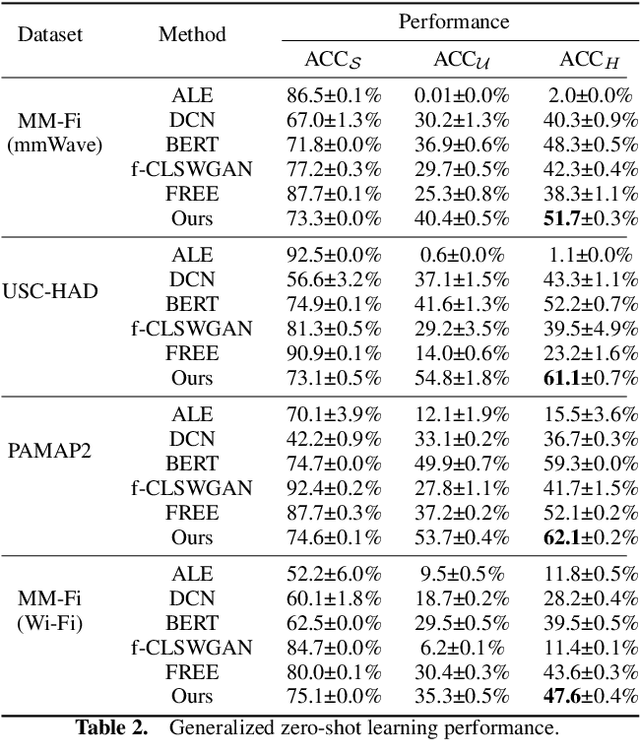
Abstract:Deep learning models are increasingly deployed on edge Internet of Things (IoT) devices. However, these models typically operate under supervised conditions and fail to recognize unseen classes different from training. To address this, zero-shot learning (ZSL) aims to classify data of unseen classes with the help of semantic information. Foundation models (FMs) trained on web-scale data have shown impressive ZSL capability in natural language processing and visual understanding. However, leveraging FMs' generalized knowledge for zero-shot IoT sensing using signals such as mmWave, IMU, and Wi-Fi has not been fully investigated. In this work, we align the IoT data embeddings with the semantic embeddings generated by an FM's text encoder for zero-shot IoT sensing. To utilize the physics principles governing the generation of IoT sensor signals to derive more effective prompts for semantic embedding extraction, we propose to use cross-attention to combine a learnable soft prompt that is optimized automatically on training data and an auxiliary hard prompt that encodes domain knowledge of the IoT sensing task. To address the problem of IoT embeddings biasing to seen classes due to the lack of unseen class data during training, we propose using data augmentation to synthesize unseen class IoT data for fine-tuning the IoT feature extractor and embedding projector. We evaluate our approach on multiple IoT sensing tasks. Results show that our approach achieves superior open-set detection and generalized zero-shot learning performance compared with various baselines. Our code is available at https://github.com/schrodingho/FM\_ZSL\_IoT.
mmPlace: Robust Place Recognition with Intermediate Frequency Signal of Low-cost Single-chip Millimeter Wave Radar
Mar 07, 2024Abstract:Place recognition is crucial for tasks like loop-closure detection and re-localization. Single-chip millimeter wave radar (single-chip radar in short) emerges as a low-cost sensor option for place recognition, with the advantage of insensitivity to degraded visual environments. However, it encounters two challenges. Firstly, sparse point cloud from single-chip radar leads to poor performance when using current place recognition methods, which assume much denser data. Secondly, its performance significantly declines in scenarios involving rotational and lateral variations, due to limited overlap in its field of view (FOV). We propose mmPlace, a robust place recognition system to address these challenges. Specifically, mmPlace transforms intermediate frequency (IF) signal into range azimuth heatmap and employs a spatial encoder to extract features. Additionally, to improve the performance in scenarios involving rotational and lateral variations, mmPlace employs a rotating platform and concatenates heatmaps in a rotation cycle, effectively expanding the system's FOV. We evaluate mmPlace's performance on the milliSonic dataset, which is collected on the University of Science and Technology of China (USTC) campus, the city roads surrounding the campus, and an underground parking garage. The results demonstrate that mmPlace outperforms point cloud-based methods and achieves 87.37% recall@1 in scenarios involving rotational and lateral variations.
Training Large Language Models for Reasoning through Reverse Curriculum Reinforcement Learning
Feb 08, 2024
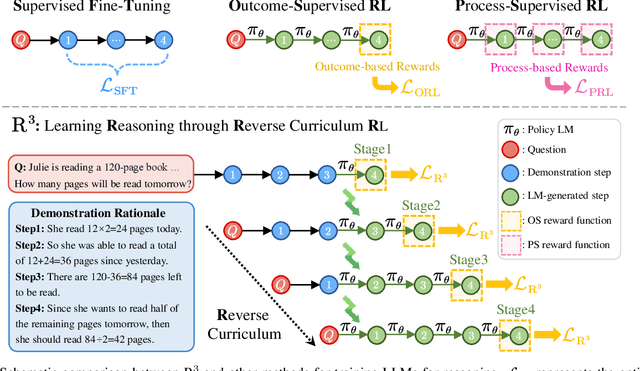
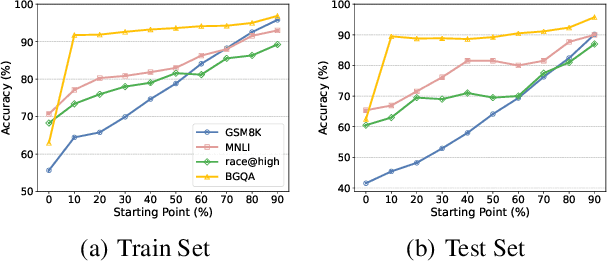

Abstract:In this paper, we propose R$^3$: Learning Reasoning through Reverse Curriculum Reinforcement Learning (RL), a novel method that employs only outcome supervision to achieve the benefits of process supervision for large language models. The core challenge in applying RL to complex reasoning is to identify a sequence of actions that result in positive rewards and provide appropriate supervision for optimization. Outcome supervision provides sparse rewards for final results without identifying error locations, whereas process supervision offers step-wise rewards but requires extensive manual annotation. R$^3$ overcomes these limitations by learning from correct demonstrations. Specifically, R$^3$ progressively slides the start state of reasoning from a demonstration's end to its beginning, facilitating easier model exploration at all stages. Thus, R$^3$ establishes a step-wise curriculum, allowing outcome supervision to offer step-level signals and precisely pinpoint errors. Using Llama2-7B, our method surpasses RL baseline on eight reasoning tasks by $4.1$ points on average. Notebaly, in program-based reasoning on GSM8K, it exceeds the baseline by $4.2$ points across three backbone models, and without any extra data, Codellama-7B + R$^3$ performs comparable to larger models or closed-source models.
StepCoder: Improve Code Generation with Reinforcement Learning from Compiler Feedback
Feb 05, 2024



Abstract:The advancement of large language models (LLMs) has significantly propelled the field of code generation. Previous work integrated reinforcement learning (RL) with compiler feedback for exploring the output space of LLMs to enhance code generation quality. However, the lengthy code generated by LLMs in response to complex human requirements makes RL exploration a challenge. Also, since the unit tests may not cover the complicated code, optimizing LLMs by using these unexecuted code snippets is ineffective. To tackle these challenges, we introduce StepCoder, a novel RL framework for code generation, consisting of two main components: CCCS addresses the exploration challenge by breaking the long sequences code generation task into a Curriculum of Code Completion Subtasks, while FGO only optimizes the model by masking the unexecuted code segments to provide Fine-Grained Optimization. In addition, we furthermore construct the APPS+ dataset for RL training, which is manually verified to ensure the correctness of unit tests. Experimental results show that our method improves the ability to explore the output space and outperforms state-of-the-art approaches in corresponding benchmarks. Our dataset APPS+ and StepCoder are available online.
MouSi: Poly-Visual-Expert Vision-Language Models
Jan 30, 2024Abstract:Current large vision-language models (VLMs) often encounter challenges such as insufficient capabilities of a single visual component and excessively long visual tokens. These issues can limit the model's effectiveness in accurately interpreting complex visual information and over-lengthy contextual information. Addressing these challenges is crucial for enhancing the performance and applicability of VLMs. This paper proposes the use of ensemble experts technique to synergizes the capabilities of individual visual encoders, including those skilled in image-text matching, OCR, image segmentation, etc. This technique introduces a fusion network to unify the processing of outputs from different visual experts, while bridging the gap between image encoders and pre-trained LLMs. In addition, we explore different positional encoding schemes to alleviate the waste of positional encoding caused by lengthy image feature sequences, effectively addressing the issue of position overflow and length limitations. For instance, in our implementation, this technique significantly reduces the positional occupancy in models like SAM, from a substantial 4096 to a more efficient and manageable 64 or even down to 1. Experimental results demonstrate that VLMs with multiple experts exhibit consistently superior performance over isolated visual encoders and mark a significant performance boost as more experts are integrated. We have open-sourced the training code used in this report. All of these resources can be found on our project website.
 Add to Chrome
Add to Chrome Add to Firefox
Add to Firefox Add to Edge
Add to Edge